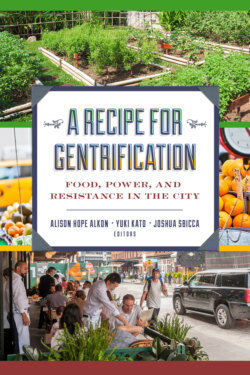Читать книгу A Recipe for Gentrification - Группа авторов - Страница 14
Urban Geographies of Food Gentrification
ОглавлениеWe chose to focus on the neighborhoods of Barrio Logan and North Park in San Diego, California because they both face high gentrification pressure but differ in their appeal to elite urban consumers. There has been significant demographic change in both neighborhoods (see table 1.1), including a rise in median property values, household incomes, and rents, especially during the first decade of this century. North Park’s gentrification began in the late 1990s, spreading north from the most affluent section of the neighborhood. Its proximity to downtown and Balboa Park, its old-fashioned main streets lined with broad sidewalks and storefronts, and the quaint architecture and relative affordability of its craftsmen- and Spanish-style cottages attracted college-educated people in search of urban lifestyles.
Change in Barrio Logan is less noticeable because the neighborhood remains home to a large low-income and mostly Latinx population, despite the rapid increase in property values and rents. For these reasons, its census tract is considered as “eligible for gentrification,” but is not yet categorized as gentrified. In fact, the transformation of Barrio Logan is still in its early stage and appears to be in part motivated by a selective attraction to the Latinx culture, including its presumed authenticity and sense of community (Dávila 2004). In contrast to North Park, where community organizations appear mostly supportive of ongoing trends, Barrio Logan’s residents have actively mobilized against budding gentrification pressures, continuing a long tradition of activism linked to the Chicano movement (Le Texier 2007).
In both places, there has been a proliferation of new restaurants, craft breweries, cafés, and alternative food spaces that are attracting growing numbers of non-residents to the area and receiving considerable media attention, giving us ample data to analyze. To map the changing geographies of food, we turned to two types of data: social media (Yelp), which reflects the opinions of relatively young and affluent consumers, and professional reviews (Eater, Thrillist, Zagat, and local magazines), which represent the perspectives of food experts—although this line between consumer and expert is becoming increasingly blurred.2 Affluent urbanites, foodies, and tourists frequently rely on these sources to identify “places not to miss,” “hottest new restaurants,” and “cheapeats” that make San Diego’s food landscape increasingly resemble New York’s or San Francisco’s. Of course, these reviews are biased and represent the perspectives of certain types of consumers, but it is this very bias that makes them useful to explore gentrification trends.
Figure 1.1 reveals clusters of “good taste” in San Diego, based on the density of positive restaurant reviews in the local media. Note that very popular restaurants that are reviewed on multiple platforms may appear more than once to reflect popularity. The core of downtown, which has historically received most of the city planners’ and developers’ attention and caters primarily to tourists and suburbanites, has the highest density of positive reviews. This cluster spreads north toward Little Italy and south toward the East Village and Barrio Logan. Although Barrio Logan includes fewer restaurants on the regional recommendation lists, a small cluster of trendy restaurants is emerging along Logan Avenue and Main Street and drawing attention among food critics and consumers alike. The attraction to “locals”—or wannabe locals—increases as one moves away from downtown and enters more residential neighborhoods. North Park is the second major foodie destination in the region, with more than seventy-three positive restaurant, bakery, or brewery reviews in the past 2 years. Here too, the historical and mixed-use character of the neighborhood is attractive to both locals and visitors.
Figure 1.1. Kernel Density of Highly Rated Restaurants in Central San Diego and San Diego County (2016–2017). Map created by author using 2016–2018 data from Yelp, Eater, Thrillist, Zagat, San Diego Magazine, and San Diego Brewers’ Guild.
The density of positive restaurant reviews in North Park and Barrio Logan is geographically tied to gentrification. As figure 1.2 illustrates, several of the noteworthy restaurants are located in census tracts that are considered “eligible to gentrify” and are adjacent to previously gentrified tracts and already established entertainment zones.3
Figure 1.2. Gentrification Trends and Location of Highly Rated Restaurants in Central San Diego, including Barrio Logan and North Park (2016–2017). Map created by author using data from the US Census of Population and Housing 1990–2010 and the American Community Survey 5-year Estimates (2016).
Areas that were recently gentrified or are on the cusp of gentrification appear to draw much attention from the food media. In contrast, those that show few signs of change, such as southeastern San Diego, rarely have a restaurant reviewed. Similarly, more established areas, that are either affluent (e.g., Mission Hills) or were gentrified decades ago (e.g., Hillcrest), lose their appeal to consumers in search of trendier places and food adventures. These patterns reflect the ebb and flows of capital that underlie uneven urban development (Smith 1996), suggesting an intimate relationship between production/economy and consumption/culture in the process of gentrification, as we noted earlier in the theoretical section of this chapter.
